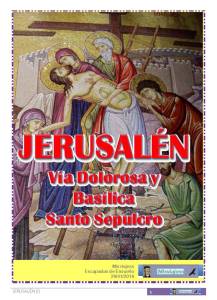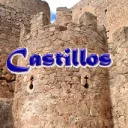• JERUSALÉN (I) Vía Dolorosa, Basílica Santo Sepulcro, El Cardo…
 En este día lo dedicamos en exclusivo a
En este día lo dedicamos en exclusivo a
- La Vía Dolorosa recorriendo el Vía Crucis con sus 14 estaciones penitenciales, y rememorando las escenas de la Pasión que Jesús padeció hasta su muerte en Calvario. Las 14 estaciones se suceden en apenas unos dos kilómetros, y en cada estación hay un templo o capilla que las recuerda el camino que Jesús realizo desde la sentencia de Pilatos hasta el Gólgota.
- Basílica del Santo Sepulcro. Este templo paleocristiano, románico y barroco sobre el lugar que custodia el sepulcro de Jesús, es conjunto de mezclas de estilos constructivos desde la construcción de Constanino (aunque el lugar de referencia esta datado entre el año 30 y 33) hasta nuestros días.
Alberga las últimas cuatro estaciones dentro del templo, además del sepulcro. Destacando los puntos principales del Santo Sepulcro, el Coro de los Griegos, la Piedra de la Unción, el Gólgota, y la iglesia de Santa Elena.
- El Cardo (también conocido como Cardo Maximus). Era la calle principal en toda ciudad Romana. Fue utilizada para desfiles y procesiones religiosas.
- Iglesia del Redentor. Este es un templo protestante, cerca de la puerta de Jaffa, se construyó entre 1859 y 1955, y alberga la confesión luterana en el sector cristiano de la ciudad.
- Y la Iglesia de Alexander Nevsky. Una iglesia rusa en memoria de un comandante ruso que fue martirizado. Un patrón del zar Alejandro III. Dentro del complejo son impresionantes restos arqueológicos de la época romana y bizantina. En las excavaciones llevadas a cabo en 1881 por el gran Duque Alejandrovich.
Puedes descargarte el PDF con información, planos, fotos y contactos.
Pulsar sobre la imagen con el botón derecho y guardar como…para descargar el archivo PDF para tu tablet o smartphone.
-
JERUSALEM (I)
This day is dedicated exclusively to
- The Via Dolorosa walking the Via Crucis with its 14 penitential seasons, and recalling the scenes of the Passion that Jesus suffered until his death at Calvary. The 14 stations succeed in just about two kilometers, and each station there is a temple or shrine that recalls the way that Jesus performed since the judgment of Pilate to Golgotha.
- Church of the Holy Sepulchre. This Early Christian, Romanesque and Baroque church on the site which houses the tomb of Jesus is set mixtures of architectural styles from building Constanino (although the landmark is dated between AD 30 and 33) to this day.
It houses the last four seasons in the temple, in addition to the tomb. Highlighting the main points of the Holy Sepulchre, the Choir of the Greeks, the Stone of Unction, Golgotha, and the church of Santa Elena.
- The Cardo (also known as Cardo Maximus). It was the main street across Roman city. It was used for parades and religious processions.
- Church of the Redeemer. This is a Protestant church near the Jaffa Gate, it was built between 1859 and 1955 and is home to the Lutheran confession in the Christian sector of the city.
- The Church of Alexander Nevsky. A Russian church in memory of a Russian commander who was martyred. A pattern of Tsar Alexander III. Within the complex are archaeological sites from the Roman and Byzantine times. Excavations carried out in 1881 by the Grand Duke Alexandrovitch.
You can download the PDF with information, maps, photos and contacts.
Click on the image with the right mouse button and save as … to download the PDF file to your tablet or smartphone.
-
JERUSALEM (I)
Cette journée est dédiée exclusivement à
- La Via Dolorosa marcher le Chemin de Croix avec ses 14 saisons de pénitence, et rappelant les scènes de la Passion que Jésus a souffert jusqu’à sa mort au Calvaire. Les 14 stations réussissent à seulement environ deux kilomètres, et chaque station il y a un temple ou un sanctuaire qui rappelle la façon dont Jésus a accompli depuis le jugement de Pilate au Golgotha.
- Eglise du Saint-Sépulcre. Cette église paléochrétienne, roman et baroque sur le site qui abrite le tombeau de Jésus est réglé mélanges de styles architecturaux de la construction Constanino (même si le point de repère est datée entre AD 30 et 33) à ce jour.
Il abrite les quatre dernières saisons dans le temple, en plus de la tombe. Mettant en évidence les principaux points du Saint-Sépulcre, le Chœur des Grecs, la Pierre de l’Onction, Golgotha, et l’église de Santa Elena.
- Le Cardo (également connu sous le Cardo Maximus). Il était la rue principale à travers la ville romaine. Il a été utilisé pour les parades et des processions religieuses.
- Eglise du Rédempteur. Ceci est une église protestante à proximité de la Porte de Jaffa, il a été construit entre 1859 et 1955 et est le foyer de la confession luthérienne dans le secteur chrétien de la ville.
- L’église d’Alexandre Nevsky. Une église russe en mémoire d’un commandant russe qui fut martyrisé. Un modèle du tsar Alexandre III. Dans le complexe des sites archéologiques de l’époque romaine et byzantine. Les fouilles menées en 1881 par le Grand-Duc Alexandrovitch.
Vous pouvez télécharger le PDF avec des informations, des cartes, des photos et des contacts.
Cliquez sur l’image avec le bouton droit de la souris et enregistrer sous … pour télécharger le fichier PDF sur votre tablette ou Smartphone.
-
JERUSALEM (I)
Dieser Tag ist ausschließlich
- Die Via Dolorosa den Kreuzweg mit seinen 14 penitential Jahreszeiten und unter Hinweis auf die Szenen der Passion, die Jesus litt bis zu seinem Tod auf Golgatha zu Fuß. Die 14 Stationen gelingt in nur etwa zwei Kilometer, und jede Station gibt es einen Tempel oder Schrein, der die Art und Weise erinnert daran, dass Jesus seit dem Urteil des Pilatus nach Golgatha durchgeführt.
- Grabeskirche. Diese frühchristliche, romanischen und barocken Kirche auf dem Gelände, die das Grab Jesu beherbergt werden Gemische von Baustilen eingestellt vom Bau Constanino bis zum heutigen Tag (auch wenn das Wahrzeichen zwischen AD 30 und 33 datiert ist).
Es beherbergt die letzten vier Spielzeiten in den Tempel, zusätzlich zu dem Grab. Hervorhebung der wichtigsten Punkte des Heiligen Grabes, der Chor der Griechen, der Stein der Salbung, Golgatha, und die Kirche von Santa Elena.
- Das Cardo (auch als Cardo Maximus bekannt). Es war die Hauptstraße in der römischen Stadt. Es wurde für Paraden und Prozessionen verwendet.
- Kirche des Erlösers. Dies ist eine evangelische Kirche in der Nähe des Jaffa-Tor, es zwischen 1859 und 1955 und ist die Heimat des Lutherischen Bekenntnisses in der christlichen Sektor der Stadt gebaut wurde.
- Die Kirche von Alexander Nevsky. Eine russische Kirche in Erinnerung an einen russischen Kommandanten, die den Märtyrertod erlitt. Ein Muster von Zar Alexander III. Innerhalb des Komplexes sind archäologische Stätten aus der römischen und byzantinischen Zeit. Ausgrabungen durch den Großherzog Alexandrowitsch 1881 aus.
Sie können die PDF-Datei mit Informationen, Karten, Fotos und Kontakte herunterladen.
Klicken Sie auf das Bild mit der rechten Maustaste und Ziel speichern unter … die PDF-Datei auf Ihrem Tablet oder Smartphone herunterzuladen

 castillode.wordpress.com
castillode.wordpress.com museode.wordpress.com
museode.wordpress.com